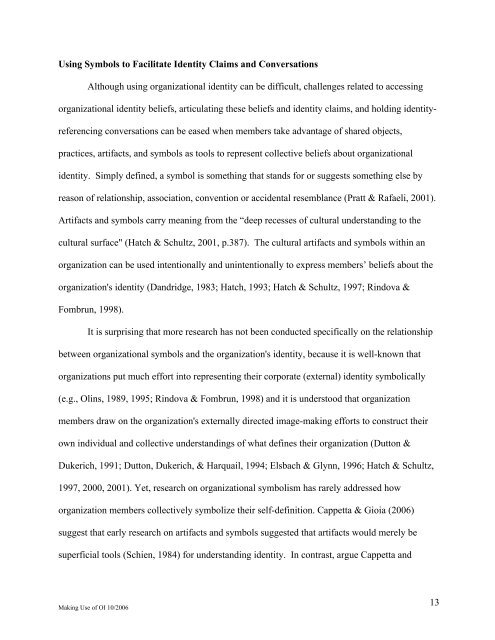Making Use of Organizational Identity - Authentic Organizations
Making Use of Organizational Identity - Authentic Organizations
Making Use of Organizational Identity - Authentic Organizations
You also want an ePaper? Increase the reach of your titles
YUMPU automatically turns print PDFs into web optimized ePapers that Google loves.
Using Symbols to Facilitate <strong>Identity</strong> Claims and Conversations<br />
Although using organizational identity can be difficult, challenges related to accessing<br />
organizational identity beliefs, articulating these beliefs and identity claims, and holding identityreferencing<br />
conversations can be eased when members take advantage <strong>of</strong> shared objects,<br />
practices, artifacts, and symbols as tools to represent collective beliefs about organizational<br />
identity. Simply defined, a symbol is something that stands for or suggests something else by<br />
reason <strong>of</strong> relationship, association, convention or accidental resemblance (Pratt & Rafaeli, 2001).<br />
Artifacts and symbols carry meaning from the “deep recesses <strong>of</strong> cultural understanding to the<br />
cultural surface" (Hatch & Schultz, 2001, p.387). The cultural artifacts and symbols within an<br />
organization can be used intentionally and unintentionally to express members’ beliefs about the<br />
organization's identity (Dandridge, 1983; Hatch, 1993; Hatch & Schultz, 1997; Rindova &<br />
Fombrun, 1998).<br />
It is surprising that more research has not been conducted specifically on the relationship<br />
between organizational symbols and the organization's identity, because it is well-known that<br />
organizations put much effort into representing their corporate (external) identity symbolically<br />
(e.g., Olins, 1989, 1995; Rindova & Fombrun, 1998) and it is understood that organization<br />
members draw on the organization's externally directed image-making efforts to construct their<br />
own individual and collective understandings <strong>of</strong> what defines their organization (Dutton &<br />
Dukerich, 1991; Dutton, Dukerich, & Harquail, 1994; Elsbach & Glynn, 1996; Hatch & Schultz,<br />
1997, 2000, 2001). Yet, research on organizational symbolism has rarely addressed how<br />
organization members collectively symbolize their self-definition. Cappetta & Gioia (2006)<br />
suggest that early research on artifacts and symbols suggested that artifacts would merely be<br />
superficial tools (Schien, 1984) for understanding identity. In contrast, argue Cappetta and<br />
<strong>Making</strong> <strong>Use</strong> <strong>of</strong> OI 10/2006<br />
13


